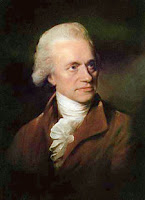William Herschel - 13 March 1781
 Discovery of Uranus
Discovery of UranusHerschel's music led him to an interest in mathematics, and thence to astronomy. This interest grew stronger after 1773, and he built some telescopes and made the acquaintance of Nevil Maskelyne. He observed the Moon, measuring the heights of lunar mountains, and also worked on a catalog of double stars.
The turning point in Herschel's life was 13 March 1781, while he was living at 19 New King Street, Bath, (now the Herschel Museum of Astronomy) when he made the first sighting of the planet Uranus. This made him famous and enabled him to turn to astronomy full-time. Naming the new planet Georgium Sidus, Latin for "George's Star", in honour of King George III also brought him favour (the name didn't stick - in France, where reference to the British king was to be avoided if possible, the planet was known as 'Herschel' until the name 'Uranus' was universally adopted). That same year, Herschel was awarded the Copley Medal and was elected a Fellow of the Royal Society. In 1782, he was appointed "The King’s Astronomer" and he and his sister subsequently moved to Datchet (then in Buckinghamshire but now in Berkshire) on 1 August 1782. He continued his work as a telescope maker, selling a number of them to other astronomers.
the Copley Medal and was elected a Fellow of the Royal Society. In 1782, he was appointed "The King’s Astronomer" and he and his sister subsequently moved to Datchet (then in Buckinghamshire but now in Berkshire) on 1 August 1782. He continued his work as a telescope maker, selling a number of them to other astronomers.
Work with his sister Caroline
In 1783 he gave Caroline a telescope and she began to make astronomical discoveries in her own right, particularly comets. Caroline also served as his full-time assistant, taking notes while he observed at the telescope.
 the Copley Medal and was elected a Fellow of the Royal Society. In 1782, he was appointed "The King’s Astronomer" and he and his sister subsequently moved to Datchet (then in Buckinghamshire but now in Berkshire) on 1 August 1782. He continued his work as a telescope maker, selling a number of them to other astronomers.
the Copley Medal and was elected a Fellow of the Royal Society. In 1782, he was appointed "The King’s Astronomer" and he and his sister subsequently moved to Datchet (then in Buckinghamshire but now in Berkshire) on 1 August 1782. He continued his work as a telescope maker, selling a number of them to other astronomers.Work with his sister Caroline
In 1783 he gave Caroline a telescope and she began to make astronomical discoveries in her own right, particularly comets. Caroline also served as his full-time assistant, taking notes while he observed at the telescope.
In June 1785, owing to damp conditions, he and Caroline moved to Clay Hall in Old Windsor. Clay Hall (or Clayhall Farm) had been owned by Samuel Foote, father of Topham Foote whose bust by Peter Scheemakers is in Windsor Parish Church. Topham's mother sold the farm to her brother Richard Topham who willed it to Sidney Bleuclerk. On 3 April 1786, William Herschel moved his family to a new residence on Windsor Road in Slough. He lived the rest of his life in this residence, which came to be known as Observatory House. It is no longer standing, having been demolished in 1963 to make way for a high-rise office building.
On 7 May 1788, he married the widow Mary Pitt (née Baldwin) at St Laurence's Church, Upton in Slough. His sister Caroline then moved to separate lodgings, but continued to work as his assistant.
Comments